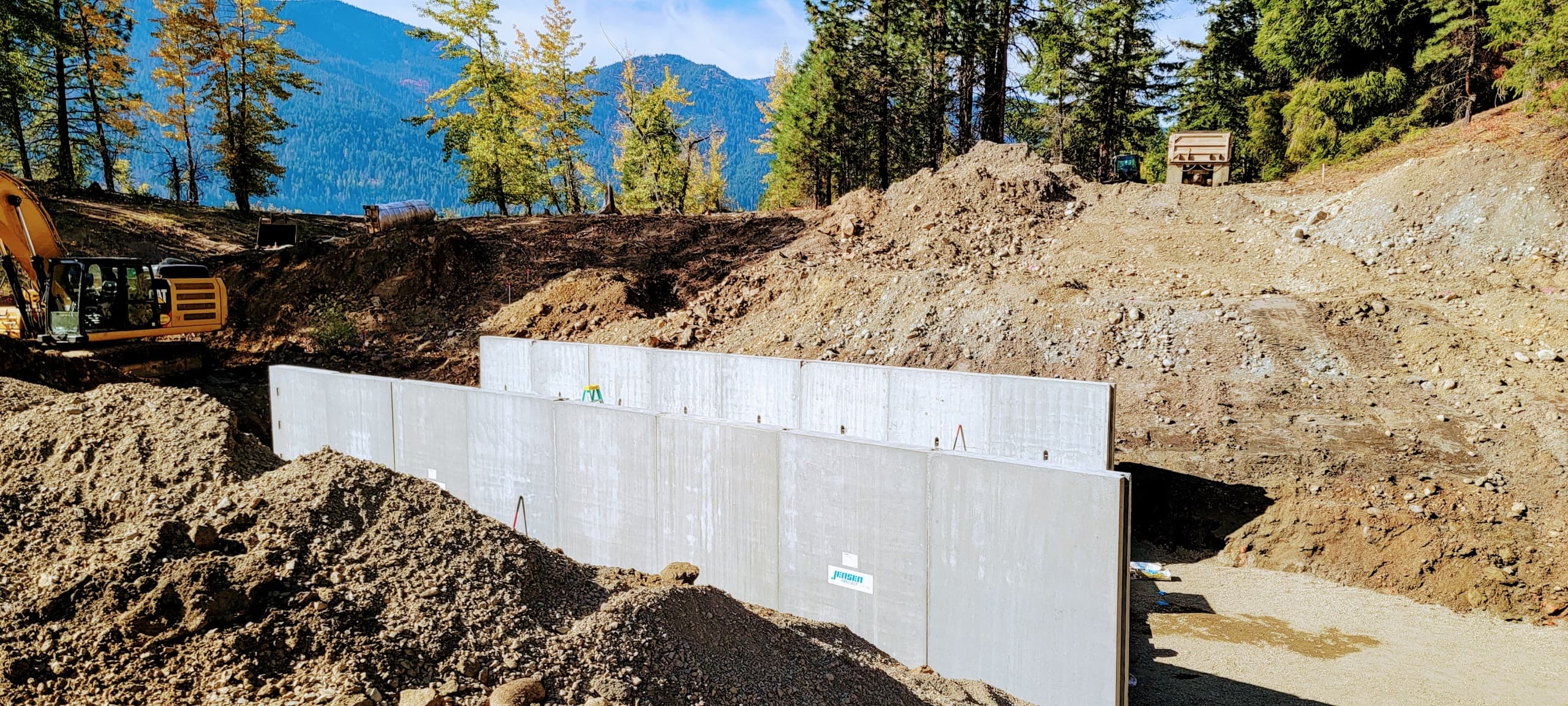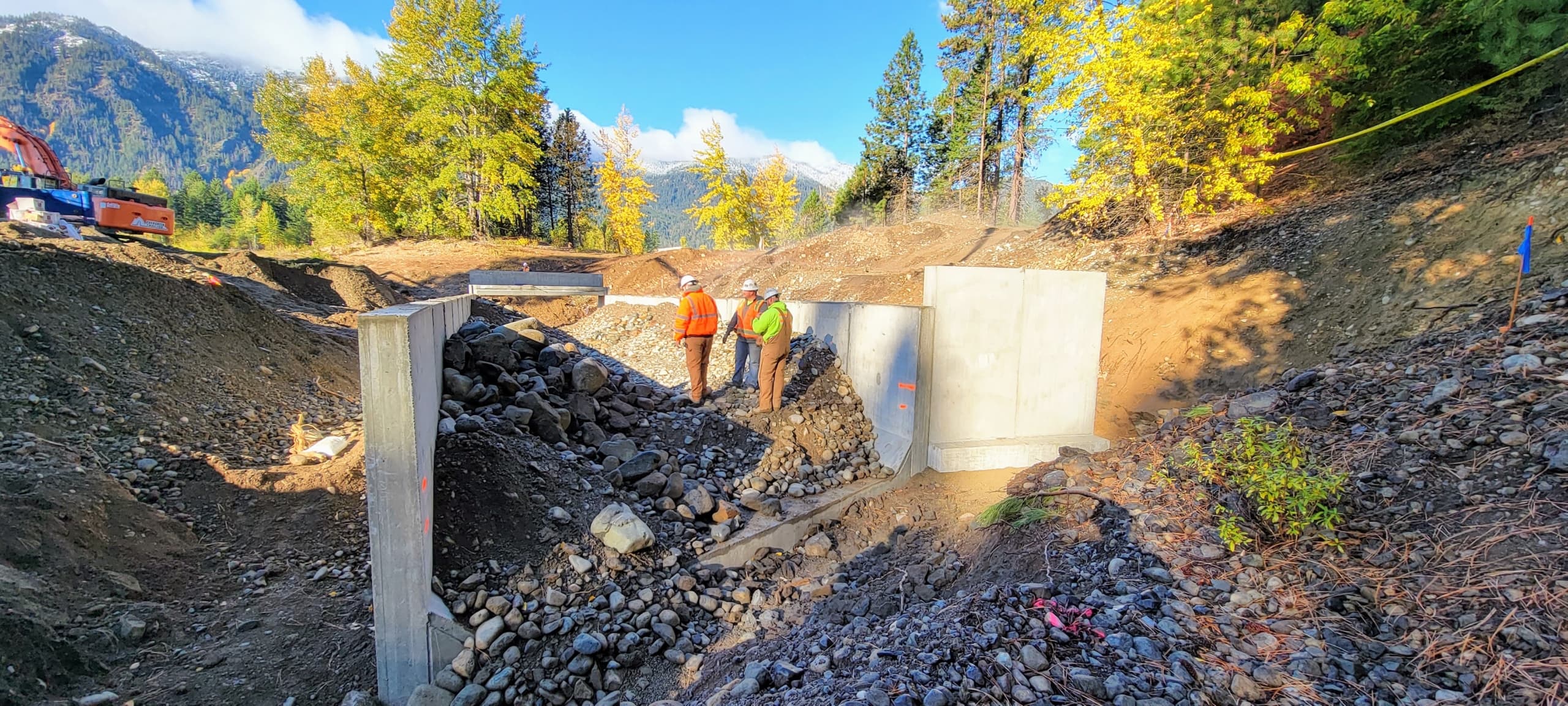Precast Culvert Opens Up PNW Fish Passage
Cle Elum, Washington
One of a host of campgrounds in the Okanogan-Wenatchee National Forest, Wish Poosh sits at the eastern shore of Cle Elum Reservoir, about 60 miles southeast of Seattle, Washington. It is a region where water supply is critical, where salmon and steelhead trout are integral to the culture, and where protecting this vital natural resource is important to many.
Fishing enthusiasts, local residents, nearby businesses, environmental groups, and even federal agencies all have a stake in the area’s beauty. So do the Confederated Tribes and Bands of the Yakama Nation, whose livelihood historically depended on a thriving sockeye salmon population. It is also an area where decades of roadbuilding and shoreline development devastated the migrating fish population that for eons had traveled freely between their freshwater spawning grounds and the sea. The devastation has started to reverse in the past 20 years, as these stakeholder groups have come together to save fish headed for likely extinction and preserve the culture of the region.
As part of a massive project, the Jensen manufacturing facility in Puyallup, Washington, was tapped to supply structures for a culvert replacement plan at Wish Poosh Campground that will enhance the fish habitat.

Raising a Reservoir
The Yakima River Basin Water Enhancement Project is a 30-year environmental protection and recovery effort that aims to raise the capacity of the Cle Elum Reservoir by 3’ total, thereby adding 14,600 acre feet of water to restore aquatic functions and enhance instream flows for fish habitat, rearing, and migration.
Raising the reservoir water mark means other waterways will be impacted but in a good way for the fish. To accommodate the higher water surface elevation when the reservoir work is completed in 2025, nearby Davis Creek will need an upgrade as well, including raising a road over the streambed.
Davis Creek is an intermittent stream with both wet and dry parts during the year. Existing corrugated metal pipe often blocks fish passage through the creek. By replacing the metal pipe with precast concrete culvert structures, a major fish migration barrier will be removed from blocking fish from precious habitat. The culvert replacement will help to make it a more robust part of the watershed.
Wendy Christensen, PE, is the Yakima Project Manager for the US Bureau of Reclamation. She sees the benefit of using precast concrete culvert to ambitiously solve complex challenges with the overall water enhancement plan.
“With the collaboration of our partners, we’ve found really innovative ways to do things, and this is one of them,” Christensen says. “We needed to raise the road, and in doing so the culvert came to light, with the need for the stream to have year-round fish passage. So our engineers designed a rather large culvert to accommodate that.”
Scott Downes, a biologist with the Washington Department of Fish and Wildlife, believes the culvert will open up major new habitat for the fish.
“Previously the steel pipe under Davis Creek was kind of a neglected 2’ or 3’ smashed in culvert,” Downes says. “There really wasn’t any passage on the creek before this project started.”



Making a Culvert Structure
Jensen Puyallup took on the Davis Creek culvert project, one of 14 fish barrier replacements in 2021 for the precast concrete manufacturing plant. It is one of the thousands of fish barriers that will be replaced in the coming decades in the state.
Tim Nyhus, Assistant General Manager for Jensen Puyallup, says the Wish Poosh culvert replacement is typical of many of the barrier culverts that his crew sees throughout the state. It replaces small, dark deteriorating pipe with wide open culvert in a natural streambed. The Wish Poosh culvert is 22’W x 100’L x 10’-8”H. It includes 15 skewed base sections, 12 skewed top sections, and 8 wingwalls.
“This Wish Poosh culvert was super enjoyable for me,” Nyhus says. “Not all of our culvert structures are equal. Some are straight legged. This one happened to be skewed. So we skew the walls on the form.”
Skewing enables the culvert to follow the Davis Creek streambed as it crosses under the roadway. When a stream curves a typical design might call for skewed sections on both ends to conform to the streamline, with straight pieces in the middle. The Wish Poosh design provides a more subtle and elegant look.
“It’s a much more complicated structure to make,” Nyhus says. “When you manufacture and install the culvert, there is more complexity in fitting the pieces together on the skew. It definitely has some additional design elements that made it a little more challenging.”
An issue of timing provided further challenges. The precast components had to be manufactured and delivered to the site 100 miles away on a strict timeline. The contractor needed to start excavation and construction after the campground closed for the season in mid-September and be out of the water before the weather turned. The precast elements provided a quick installation once the site was prepared.
The contractors, Belsaas & Smith Construction, had the precast installed by mid-October, according to co-owner Bryan Nelson.
“The biggest stress was getting it done before it snowed, because we’re up in the mountains and we were already getting some winter weather,” Nelson says.
The Jensen contribution to fish barrier removal in the state has not gone unnoticed among the production workers who are crafting the culvert components that contribute to the barrier removal, according to Nyhus. Now, when the Cle Elum Reservoir is at full inundation, the new Jensen culvert enables Davis Creek to open up.
“The reservoir actually backs up through that culvert,” Downes says. “It’s a great off-channel habitat for fish, and now with passage through it, there is probably another mile of habitat for the fish to be able to spread out, forage, and grow bigger. All the things that fish populations need to improve their numbers.”



The Importance of Precast
Gary Venn, Jensen Pacific Northwest General Manager, says these types of projects give the workers who make the products a closer look at how they are contributing to the rebuilding of this vital environmental infrastructure.
“Our employees are engaged in what they’re making,” Venn says. “They understand the culvert business and what we’re trying to create. We’ve started a process of having individual employees go to these jobsites to see what they’ve made. That is going to continue. As soon as you go out to a jobsite and see some of the issues a contractor has, then you take ownership of the quality. I want to engage our employees with the end-product of what they’re making.”
Nyhus agrees with the connection between the workers and what they make having an impact on the team culture.
“The way we approach it overall, I think most of our people understand the impact it has beyond just being concrete,” Nyhus says. “From the wetcast fabricators all the way through management and sales, we understand how important it is. It’s important for our community. It has created a huge market for us as precasters, so we embrace it and take it pretty seriously.”
Looking at it from the fish biologist standpoint, Downes says it was one more example of many groups with varied interests working together to restore the fish habitat for the many stakeholders in the region. “I stopped out there about a week ago and the culvert looks great,” he says, “and we expect it will meet all the specs that we were hoping for.”
Jensen specializes in complete solutions for fish passage replacement projects. Get a quote for your next job now. Or contact Jensen in the Pacific Northwest at (253) 929-1818.












